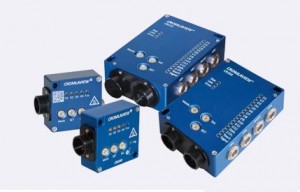The CROMLAVIEW® CR200 color sensor processes colors in a perceptual way (i.e. according to human perception). The two channels allow for applications that demand high standards of the sensor technology. By using the second color sensor channel this sensor can be used in different modes of operation. In the dual channel mode the sensor can be operated as two single sensors, which work with the same gain and illumination intensity. With the activated stabilization function (CROMLASTAB®) the sensor can be used with an external stabilization target as a single channel sensor. The symmetric design of the sensor facilitates very high drift stability against age and temperatures. In the color difference mode, compliance and synchronism between the two sensing channels are crucial. The balancing method CROMLABALANCE® is available for this purpose. It allows for simple and effective channel balancing over the client’s entire color space.

Operating Principle:
Differential color detectionFeatures:
- Two color sensing channels Color differences can be detected and displayed
- Up to 350 colors, respectively color differences can be stored
- Quick response time from 50 µs
- 12 channels, with binary encoding up to 4096 output combinations
- Finest color differences can be detected (ΔE < 1)
- Standard interfaces: USB, RS232, 12 pushpull outputs (24 V/100 mA)
- PC software CR-tool for parameter setting and visualization of color values Applications
- Print mark detection
- Check the presence of assembly parts
- Checking functional and color coatings
- Color inspection for quality assurance
- Sorting tasks Options and accessory
- External stabilization target
- CR-TBox
- Fiber optics
- Optics
- Fiber spacer
- USB cable T
Application:
- In the dual channel mode the sensor can be operated as two single sensors, which work with the same gain and illumination intensity.
- With the activated stabilization function (CROMLASTAB®) the sensor can be used with an external stabilization target as a single channel sensor. The symmetric design of the sensor facilitates very high drift stability against age and temperatures.
- In the color difference mode, compliance and synchronism between the two sensing channels are crucial. The balancing method CROMLABALANCE® is available for this purpose. It allows for simple and effective channel balancing over the client’s entire color space. When teaching in a “zero-difference” between the two color channels, test objects can be inspected for color identity, even if the absolute color has not been fixed. A zero-difference can also be used for edge detection. Another advantage of the color difference mode is the recognition of transparent objects against changing backgrounds (e.g. transparent labels in the packaging industry). Changing backgrounds can frequently occur in terms of deviations in height or structure of the object. Also in such cases, the color difference mode facilitates the recognition of colored structures, which would otherwise be impossible with an absolute measurement.
Specification:
- Sensing channels 2 Sensing channels
- Drift stabilization CROMLASTAB®, can be switched off
- Receiving detector, Three range photo diode
- Sensitivity Adjustable by user
- Sensitivity steps 8 (1x, 4x, 20x, 40x, 80x, 200x, 400x, 800x)
- Receiving signal resolution 3 x 4096 steps
- Object illumination High-power white light LED, Adjustable (4096 steps) Can be switched off
- Ambient light compensation Can be switched off
- Standard interfaces 12 Switching outputs 2 Control inputs Serial (RS232) USB
- Displays 19
- LEDs for outputs and status
- Buttons 3 buttons for Teach-In
- Color resolution ∆ELab < 1
- Response time ≥ 50 µs 1)
- On-/Off-Delay 0 ms … 65535 ms
- Hysteresis 0 % … 250 %
- Color output channels 12, up to 350 at binary encoding
- Protection standard IP 54
- Power supply 18 … 28 VDC, max 500 mA
- Case temperature during operation -10 °C … 55 °C
- Coupling in signal path Via optical fiber
- Case material Aluminium, anodized
- Case size 100 mm × 70 mm × 30 mm
- Weight Approx. 260 g
